This should say it all!

Keep on Jammin’
Guitars, tips and great music discussions
by Chris
This should say it all!

Keep on Jammin’
by Chris
Gibson has a section in their site dedicated to the identification and meanings behind their serial numbering system.
So my serial number is 72657067.
YDDDYPPP
YY is the production year
DDD is the day of the year
PPP is the plant designation and/or instrument rank
YY = 72657067 : 77 = 1977
DDD = 72657067 : 265 =
PPP = 72657067 : 067 = 67th made on that day
Can anyone help me in figuring out what the DDD is the day of the year is because it is just baffling me to know end! I took this quote directly from the Gibson website and it’s hard to follow.
Thanx in advance!
Keep on Jammin’
by Chris
Basically making a Humbucker pick up(p/u) is when you place a single coil beside another one.
Visually you will notice that some Humbucker p/u’s may have a cover on them, thus you will not see the two coils side by side. I will try to explain that one in another post.
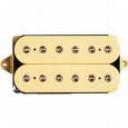 Both coils generate a signal that comes from the strings that are vibrating or making sound. If you pluck a string it will vibrate in a certain direction and height. During one complete cycle it will move closer and then farther away from the pick up itself. By placing two of them side by side obviously gives you more signal/sound output that comes out the the p/u and into the guitar amplifier.
Both coils generate a signal that comes from the strings that are vibrating or making sound. If you pluck a string it will vibrate in a certain direction and height. During one complete cycle it will move closer and then farther away from the pick up itself. By placing two of them side by side obviously gives you more signal/sound output that comes out the the p/u and into the guitar amplifier.
These coils are wired together in a configuration called series.
 For people just trying to grasp at this idea, here goes nothing. Both of the coil’s wirings are opposite to each other.
For people just trying to grasp at this idea, here goes nothing. Both of the coil’s wirings are opposite to each other.
When you wrap the wire around the coil, it can be wound either by clock wise or counter clock wise direction. This is better known as polarity, or the direction of how the signal is sent to the amp. In guitar terms it is better recognized as reverse winding and reverse magnetic polarity called RWRP.
For guitarist in the know, the RP is how the pick ups are wired to each other.
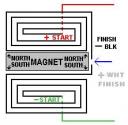 With a single coil p/u, it generates a certain hum from it. For some, this drives them mad and others love the effect. I tend to fall in the middle of this one. Both sounds are very unique. So now having two coils in RWRP, the EMF effect, offsets the other one thus making a hum less p/u with more power. BTW, this is the reason why they called it the HUM-BUCKER pick up, get it? Also by adjusting the height of the p/u, you change the sound and output of it.
With a single coil p/u, it generates a certain hum from it. For some, this drives them mad and others love the effect. I tend to fall in the middle of this one. Both sounds are very unique. So now having two coils in RWRP, the EMF effect, offsets the other one thus making a hum less p/u with more power. BTW, this is the reason why they called it the HUM-BUCKER pick up, get it? Also by adjusting the height of the p/u, you change the sound and output of it.
This link is to a How to make a Humbucking Pick Up thus giving you a complete visualization of the structure and a better idea of how it works. I tend to be a more visual person in how I learn, some people learn more by audio means.
I hope that I did not confuse anyone with this post. I just want to give the average person a better/basic working knowledge of how this system works!
Keep on Jammin’
by Chris
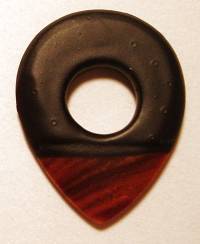 I have a pick made of gold, honestly I do, and I’ve used it too … but one made of wood – never heard of one.
I have a pick made of gold, honestly I do, and I’ve used it too … but one made of wood – never heard of one.
They say the Surfpick Lignum Vitae is much denser then white oak, gives you a richer warmer tone and that it makes your sound free from the dreaded pick click sound.
The wood is rare so it’s no wonder they can’t ship out of the US.
The wood is so dense it will sink in even salt water.
It was also prized for use for fittings on tall ships hundreds of years ago.
You can even watch it burn on the video.
If you have one of these picks in your arsenal, will you get back to us on what your thoughts about this is?
Keep on Jammin’
by Chris
I have been using my Fender Lead II as of late. I only have one guitar stand and I rotate the guitars that I put in it many times throughout the year.
I got this guitar off a exchange student from Japan around 1984-85. Oddly enough, this is a Student Guitar, meaning the body is smaller making it easier to play. He was a little low on funds and he wanted to know if I wanted to by it. At first I started to give him lessons and he was not that bad if memory serves me correctly.
While looking at my black Fender I started to wonder what year this baby was built so a Googling I will go!
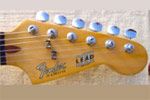
This site was the one that I ended up at. You can normally determine the age of your guitar by the serial numbers. Mine is “E0 09736” so it’s made in 1980, that makes it 27 years old! If you have a Fender guitar just sitting around the house, go and get it and find out how old your is. Get back us on that one if you have one.
I just love the sound of the X-1 single coil pick ups on this one. You can raise the pick ups by turning the 2 screws at either end of the pick up clock wise. This adjustment brings the pick up closer to the strings thus you get a stronger signal.
There is a phase reversal switch that works when you are in the middle position or using both pick ups at the same time. This switch is really nice to have at your disposal.
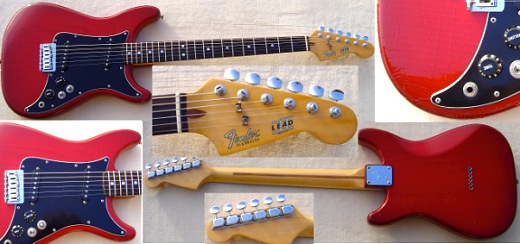
I know I will try to get a picture of mine up here soon!It has 21 medium Jumbo frets with a 4 bolt neck piece. It has a “Soft V or C†profile neck, which means the part of the body which attaches to the neck section of the guitar. The neck itself is maple. The small headstock is a nice reminder of the past Fender guitars that were built between 1954-65. Oh, headstock is part where you tune the strings on the “head” of the guitar in case your unfamiliar with guitar terms.
The bridge, where you put the strings on the body of the guitar, is designed after a Fender Telecaster. Keith Richards plays this type of an axe.
As far as I know it was made at the Fender Fullerton California plant. It was also one of the last fender guitars to be made at this legendary location!
So hats off to my 27 year old gal and hope we’re together a lot longer!
Keep on Jammin’
by Chris
While looking for thumb picks to try and spice up my picking style, I came across the regular/traditional plastic ones and the newer look and feel plastic and metal ones.
I know that you’ve all seen the plastic thumb picks before and they all seem to have the same feel to them. When you put them on they have this loose tension to them. It has the illusion that it would slide off my thumb fairly easily and that poses a problem with me. While playing hockey I tend to almost squeeze the sap out of it when playing and I bring that attitude to my guitar game.
The one that Tim Cameron directed me to was the National “L” one. 
This one has a different feel to it all together. It has a nice firm feel all the way around your thumb, but the exposed pick maybe a little bit too big and clunky for my liking.
The next one that I was shown was a little bit unique from your everyday thumb pick. This one is called the PROPIK.

The one to the left is called a Good Grip Thumb Pick.
I liked this one because it allows me to adjust the tension of it to my liking. The best feature of this one is that the exposed pick that I will attack the strings with is smaller then most thumb picks.
I do not need a big clumsy thing on my thumb that is not as precise as a regular guitar pick. Therefore I give this product one thumbs up! Get it?
If you use any of these picks, please let us know the pros and cons of each one!
Keep on Jammin’
by Chris
As you know I’m trying to add a little something to my guitar picking techniques. I went to the 12th fret in Toronto and looked at some unique picks that I have or have not used in the past. As usual Mr Tim Cameron was the one who stepped up to the plate and let me delve into his insight of guitar picks and styles.
I had told him that I was trying to use a regular pick with thumb and index finger then move it to the ring and pinkie. He then tried to show me his way while playing air guitar,but then he decided to pick up a guitar beside him in order to show me the fine details.
He tends to grasp the pick with his index finger and then he closes his hand to where the knuckle and palm of his hand meet. It’s almost like making a fist, but he uses all the other fingers to pick.I never thought about way this, but the only problem with this is that I want to use my index finger while picking.
He uses a Snarling Dogs Brain pick that has tons of grip on the top portion of the pick. Check this out and look at the larger view. I’ve never seen, heard of or played with this type of pick before, but if you are a player who sweats a lot while playing then this IS the pick for you.
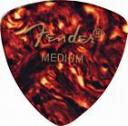 He then showed me the traditional Fender HEAVY pick, that has a tortoise shell swirly design. It has a Reuleaux triangle configuration.
He then showed me the traditional Fender HEAVY pick, that has a tortoise shell swirly design. It has a Reuleaux triangle configuration.
This pick is just about the correct size I need, but it is too smooth to move back and forth from the intended positions. If it had finger grip patterns on it, it would be not bad. I bought it anyway and will try it out for a while.
Next topic will be the traditional and non-traditional thumb picks.
Keep on Jammin’
by Chris
Has anyone out there heard of this guitar maker? I found out about these guys through a patient that I was taking back to their room after a procedure. The patient was a bass player and said that it was the pride of the collection. So curious about it I went and googled it.
To my amazement the makers were none other them Leo Fender – Maker of all pre-CBS Fender as well as Music Man instruments – and George Fullerton.
Leo Fender, we all know who he is but, the other guy, not so much. George Fullerton is the co-creater of the Fender Stratocaster. Not a bad thing to have as a lasting legacy of a man now is it!
G & L was the result of Leo having to sell his company in 1965 due to health problems that he was having in the early 60’s. It was started up in 1980 at the same location that had housed his Clarence Leo Fender Research (CLF) facility.
Some of the musicians who use these beauty’s are personal favorites of mine. For example:
Carl Perkins, Canada’s own Gord Sinclair (The Tragically Hip), Peter Frampton and Bob Mayo (Peter Frampton Band), Neal Schon (Journey), Davey Johnstone (Elton John band), Gary Hewitt (Gary Allan Band) and all the guitarists from Aerosmith and INXS. Just to name a few.
If you happen to come across this post and own one of these beauty’s PLEASE write a comment here about your experiences about your axe. We’d really like to hear from you, please?
Keep on Jammin’
by Chris
My question to all of you guitarists out there is, does anyone out there place their guitar picks in between their 4th and 5th (consider their thumb as 1st finger etc.) finger while using their remaining fingers to play bare finger picking during certain parts of a song?
I’ve been trying different ways to bring the pick from the 4/5th fingers up to the regular position for years with very slow results.
I am just missing a fine detailed part of the process to make it flow effortlessly.
Can anyone out their give me a different aspect on how to do this?
If someone knows of a video on line to assist me I’d be in their debt forever.
Keep on Jammin’
by Chris
I was introduced to the Vox Tonelab SE peddle by a guy who I was playing with this past weekend at the Arlington Hotel’s Capron’s Cavern, Paris Ontario.
The event was being held for a dear family friend who was celebrating his 50th birthday. Craig Peeler was the guitarist who played a wide variety of tunes. I brought along my Larivee and he graciously let me jam with him on stag that night.
Wow, I was at Steve’s Music on Queen St. in Toronto today and I was looking at a Vox ToneLab SE. This thing looks HOT! Unfortunately they did not have this in stock but was getting them in this week.
John Boldt was the rep. that I was talking to and he was very up to date on his pedals. He was saying that 12AX7 dual triode vacuum tube is used at the end/output of the inside mother board of the floor peddle. This has quite the warming effect on the sound. The tube is not used for the power of this system! He said that most pedal companies are using the vacuum tube at the beginning of their process but Vox was using it at the tail end instead. This makes sense because you would always want a warmer tube sound coming out the speakers.
I would recommend this little piece of equipment heaven for anyone’s collection!
Keep on Jammin’